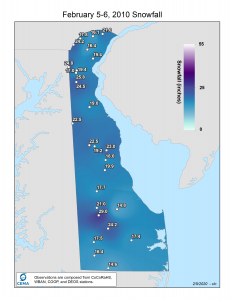February Temperatures
Preliminary data indicates that the statewide average temperature in February was 37.0o F, which is 0.1o F below the 1991-2020 mean value of 37.1o F (Figure 1). February was the third month in a row with below normal temperatures for the State.
February Precipitation
Delaware’s statewide precipitation for February 2025 averaged 3.16 inches, 0.25 inches above the 1991-2020 mean of 2.91 inches (Figure 2). February was the first month since July 2024 with above normal precipitation across the State.
Statewide Spatial Anomalies
Data from the Delaware Environmental Observing System (DEOS) show that temperature departures varied across the State, with generally small positive or negative anomalies depending on the specific location (Figure 3). A significant snowfall event took place on February 11th with over six inches of snow falling over much of southern Delaware with totals decreasing from south to north (Figure 4).
National Anomalies
Temperatures were above normal across the eastern United States, along the Gulf Coast, and in the Southwest (Figure 5). Temperatures were below normal across the Great Plains, northern Rockies, and the Pacific Northwest. Extreme cold was found across portions of Montana and the Dakotas where negative anomalies were greater than 9o F in some regions. Precipitation varied greatly across the country (Figure 6). Much of the Ohio River Valley and the eastern Great Lakes saw above normal precipitation amounts, while the Midwest and Southeast saw generally below normal precipitation. The 500 hPa height pattern for February showed an anomalous jet stream trough across the northern Great Plains and Pacific Northwest (Figure 7) contributing to the temperature anomalies across the country.
Global Anomalies
February 2025 ranked as the third warmest February on record for the globe since 1850. Global temperatures were 2.27o F above the 1901-2000 mean. Particular warmth was found across the Arctic, with northwest North America seeing significant cold (Figure 8).
- Figure 1. Delaware statewide mean February temperature (degrees F) 1895-2025. The black line indicates the 1991-2020 normal (NOAA, NCEI, Climate at a Glance: Statewide Time Series).
- Figure 2. Delaware statewide February precipitation (inches) 1895-2025. The Black line indicates the 1991-2020 normal (NOAA, NCEI, Climate at a Glance: Statewide Time Series).
- Figure 3. February 2025 average temperature departures (degrees F) from the 1991-2020 mean based upon DEOS station data.
- Figure 4. February 11, 2025 snowfall totals (inches) based upon DEOS station data.
- Figure 5. United States climate division temperature anomalies (degrees F) for February 2025 (NOAA, NCEI, Climate at a Glance: Divisional Mapping).
- Figure 6. United States climate division precipitation anomalies (inches) for February 2025 (NOAA, NCEI, Climate at a Glance: Divisional Mapping).
- Figure 7. 500 hPa geopotential height anomalies for February 2025. Negative (blue) anomalies indicate the presence of an anomalous jet stream trough while positive (red) height anomalies indicate the presence of an anomalous jet stream ridge.
- Figure 8. Global temperature anomalies (degrees C) for February 2025 (NOAA, NCEI, Climate at a Glance: Global Mapping).












































































